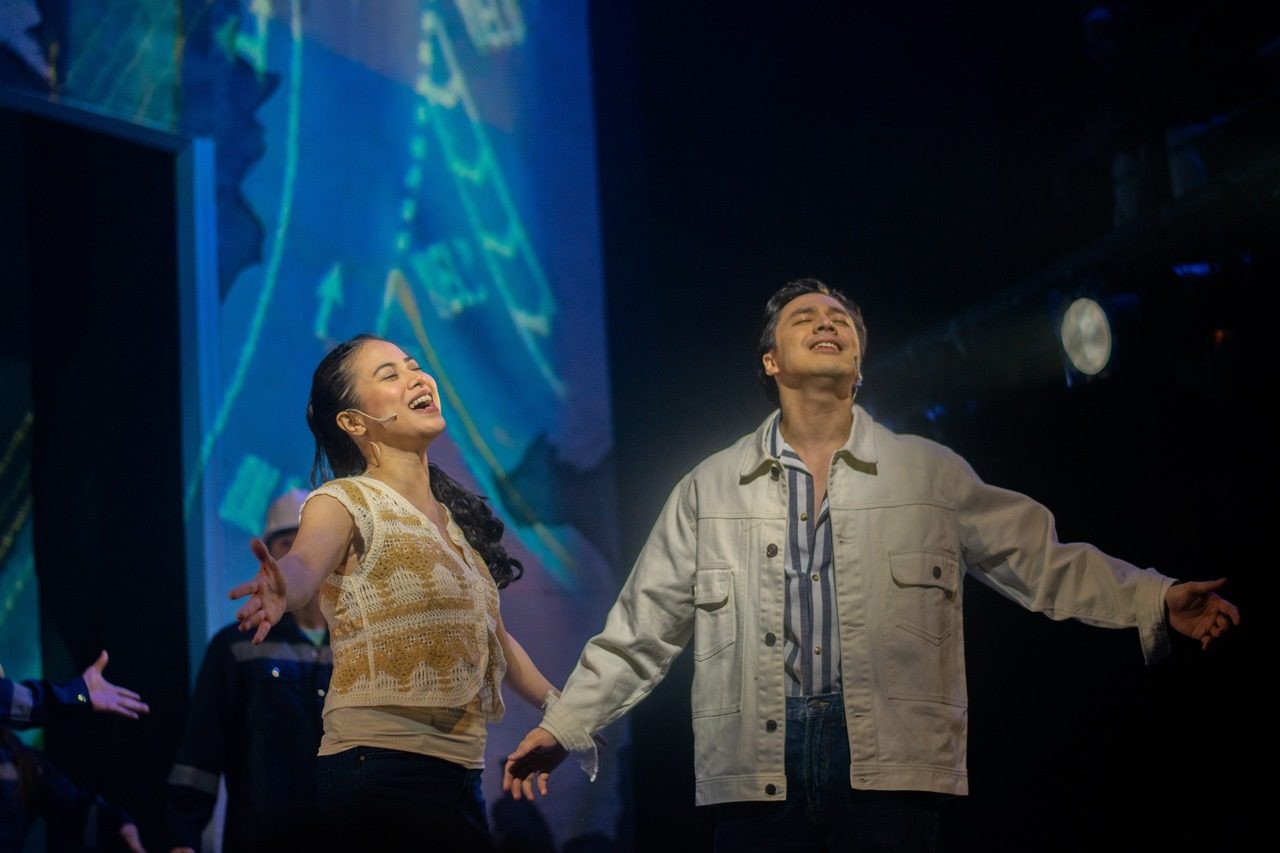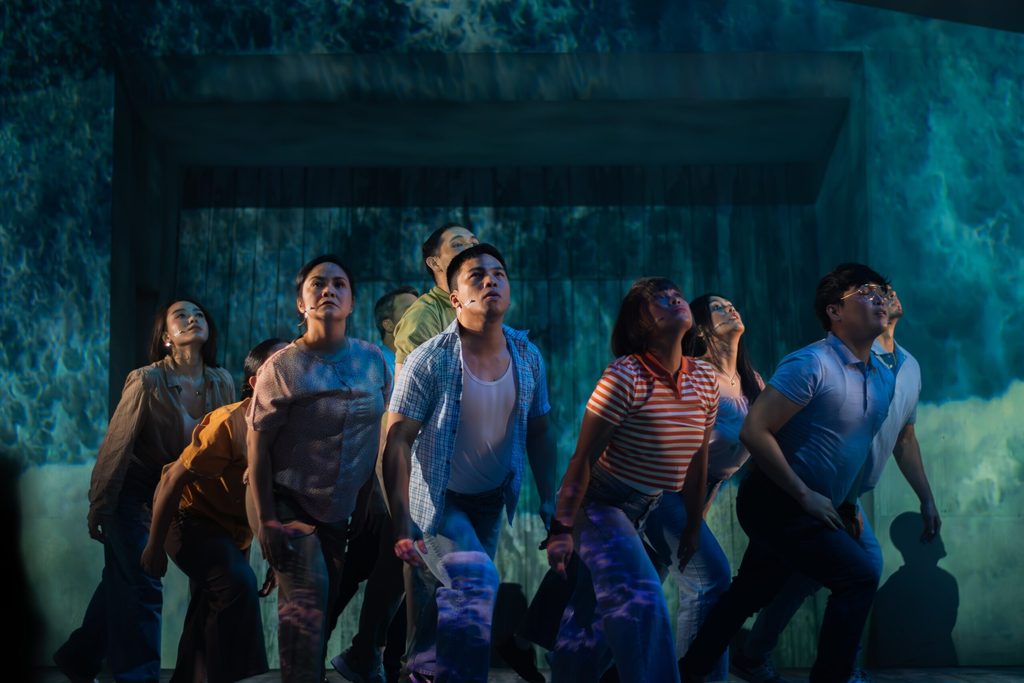SUMMARY
This is AI generated summarization, which may have errors. For context, always refer to the full article.

Spoilers ahead.
Much like the movie with which it shares a title, One More Chance: The Musical by the Philippine Educational Theater Association (PETA) asks for another chance to measure up to its promise. From a marketing viewpoint, staging a work as huge as One More Chance, starred by a beloved love team of its time, with the music of the indie folk-pop band Ben&Ben, one of today’s most successful local acts and in fact the most streamed Filipino artist of all time, makes for a sound proposition to attract more and new audiences, especially now that local theater is experiencing a resurgence post-lockdown.
Of course, there’s a common thread: both the movie and the music thrive on hugot, a selling point magnified by the viewers’ immense longing for a specific period. Nostalgia, after all, is an integral marker of the Filipino audience’s behavior as far as art or media consumption is concerned. We love to caress a time long gone as much as we debate about it. Revisit the past so as to make sense of the present, if not imagine the future.
From time to time we wolf down new content out of the sheer energy to compare it with its predecessor. At times, we even mask it as “discourse.” It’s a vice that’s hard to kick out of our system. Take a quick look at Twitter/X, and see for yourself.

If you think about it, One More Chance: The Musical works as both time capsule and time traveler. While the source is seemingly fixed in time, its sensibility moves past that limit. The movie itself may not change, but its audience does. And toying with temporal and cultural distance, for theater in particular, often yields exciting results, as it makes room for new ways of framing. Shelved for seven years, there must be a good reason why the project now finally comes to fruition. In this case, though, the reimagining seems to require more rethinking.
A flawed vision of lasting beauty, One More Chance is a perfect case of a modern cult classic, primed toward sketching and parsing the “anatomy of a breakup.” It harnesses relatability as its staying power. Over time, whether or not we admit it, it’s become the blueprint for several movies of its kind. We meet Popoy and Basha, college sweethearts trying to nurse their fractured, disintegrating relationship, and we’re enamored with both the hurt and kilig shaping these characters, for better or worse. In them, we find a space to talk about our complex inner lives, to look at love with a different set of eyes.
PETA’s adaptation, with director Maribel Legarda at the helm, keeps this burning message intact. The sense of materiality is not lost in the script by Michelle Ngu-Nario, engendering discussions about power dynamics, gendered expectations, and mental health — discussions that are rendered more towering in the current context. To be this close to Popoy and Basha, in many ways, induces more intimacy.

With them, we “break down so [we] can get to [our] breakthroughs,” as the playwright puts it. The core takeaway stays the same, but also feels vastly different, and it’s a particularly powerful message, sharpened with the benefit of hindsight.
But should a strong message absolve the staging of its glaring lapses? The response hinges of course on our persuasions, but we might as well consider other ways of seeing. If the point of the musical is to tour us around familiar sights and insights, then it does its job. But if we’re to shift the inquiry to the show’s artistic decisions, then the discussion might find itself on shakier ground.
Here’s a good starting point: the staging, for all its resourcefulness, incorporates a giant digital backdrop that features audio-visual work largely generated through artificial intelligence (AI). The use of a digital wall is of course not unique to One More Chance: The Musical, as it’s becoming a common fixture in other stagings, musical or not, local or otherwise. On the one hand, it’s convenient for plot points involving video calls and online messaging, but on the other, it draws unnecessary attention, distracting the audience from truly connecting with the actors onstage, especially in moments of tension and tenderness. Simply put, it’s visually disorienting.
Consider the moment when Popoy (Sam Concepcion) learns that Basha (Anna Luna) wants to break up with him, and how it becomes difficult for the audience to absorb, let alone focus on, the internal turmoil when the screen displays Concepcion in what seems like a 2007 music video, all dazed and confused. It feels like standing in the TV aisle at a local appliance store, after running errands, listless and eager to call it a day.
The digital background does the production more harm than good, like the opening dance sequence, a doxology of sorts, replete with images of water, which seems misplaced in the context of the story. Above all, it hijacks the staging’s integral moments. When Basha runs into Mark (Jay Gonzaga), an architect like her, you constantly get distracted by the faux greenery looming behind them. When there is tension among the characters in the makeshift car, which proves to be quite the prop, the pseudo rain ruins it altogether. With this kind of projection, an unfinished house, or perhaps a busy construction site, registers like those you encounter in a video game that badly needs updating.

On rare occasions that the staging sparingly uses AI, everything feels more lived-in. Prime example of which is when Popoy and the rest of the gang gather in a resto bar to drink their sorrows away. It’s the best part of the show precisely because it relies on the human-scale talent onstage, on the actual performance.
Without all the noise on the big screen, it feels fresh and far more alive, spiked with a terrific rendition of Ben&Ben’s Langyang Pag-ibig and Michael Barry Que’s exhilarating choreography. Here, the writing is also at its sharpest. The theatrical punchlines, as opposed to a scene suffused with endless nods to Korean culture bordering on caricature, are not carried to excess, providing the audience a true interval for entertainment and reflection.
Had the staging realized early on that it could do away with the flickering backdrop, just as it could usefully shave some parts of its three-and-a-half-hour runtime (longer than the movie itself!), it would have come up with far better results.
The projections hardly exhibit beauty and quality; it’s bland and rudimentary at best. Moving past the issue of aesthetics, though, what’s more concerning is that a theater company of PETA’s caliber is willing to resort to AI, perhaps a budget restriction, but PETA knows for sure that theater is a product of creative and cultural work, which points to issues concerning labor and artistic ownership at large.
Isn’t it a disservice to a community of talented, hard-working artists to promote the very thing that jeopardizes their livelihood, that renders them more susceptible? To thieve original ideas, instead of creating more spaces to accommodate them? For a staging that’s supposed to be grounded on material reality, PETA’s reliance on AI betrays that very objective.
The show also concedes to product integration, which isn’t necessarily a bad thing. References to Max’s Restaurant, Metrobank’s tagline “you’re in good hands,” and Robinsons Malls blend well with the silly gags, although it can get excessive at times. The inclusion of such brands in the show speaks of the modern theater economy, which necessitates compromises between artists and their sponsors, to juice more income.
But of course the most significant brand in the staging, apart from the Star Cinema movie itself, is Ben&Ben, whose music is marketed by musical director and sound designer Myke Salomon in as many packages as possible. Salomon has done similar work for PETA through Rak of Aegis (2014) and 3 Stars & A Sun (2016). Here, his work parallels the experience of listening to the band’s discography — a push and pull, oscillating between spectrums of incredible and taxing. It’s not that it’s a jukebox musical.
It has to do more with the way Salomon injects the music (23 tracks in total) into the narrative, as though it’s an add-on that accompanies the material more than expands it. At a certain point, a song overwhelms the feeling it’s supposed to evoke; or the music simply crawls its way into a scene, if not interrupts a dialogue, and expects that it goes unnoticed, despite the towering disconnect it elicits.
Add these to other production mishaps like the main door opening even as the performing actor exits the other way, lighting technicians missing their cues, or the instances when planting the staircases and scaffolding used as main props takes so much time, hence the show’s duration.
However, if there is any highlight in the show, it’s the understated tenacity of Via Antonio as Anj, whose tough love steers Basha toward self-awareness, keeping her grounded. Antonio is especially mighty with the way she draws out every wire of emotion and humor from the material. It’s hard not to restrain a giggle when she turns so animated or begins to nail riotous one-liners. Her work offers a wealth of experience — generous but never excessive.

With his arsenal on full display, Sam Concepcion also makes a strong case for himself. He maps out the staging’s emotional timbre through sheer force and some extraordinary pipes he’s got. He’s also sexy as fuck. In Upuan, a much finer rendering from Salomon, he’s particularly beguiling in the ways talent and charm meet. In Nakikinig Ka Ba Sa Akin, he’s a walking red flag, exposing traumascapes, but even that looks so tempting in his grasp. With Concepcion, there’s boundless vocabulary for appraisal, which makes you think what CJ Navato, who alternates in the lead part, has in store.
But such performances, brilliant as they are, cannot make up for the rest of the staging, which undercuts its own potency with rather risky artistic decisions. Second chances, as we’re all aware, can only go so far. – Rappler.com
One More Chance: The Musical runs until June 30.
Add a comment
How does this make you feel?
There are no comments yet. Add your comment to start the conversation.